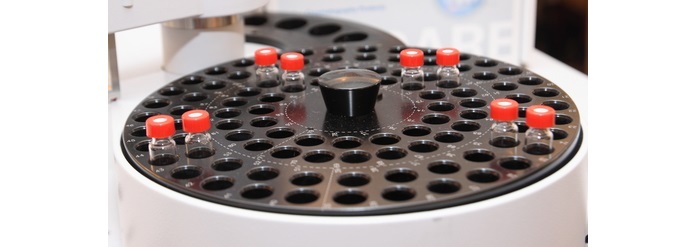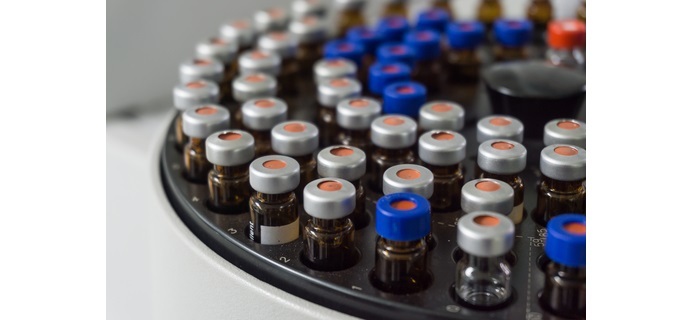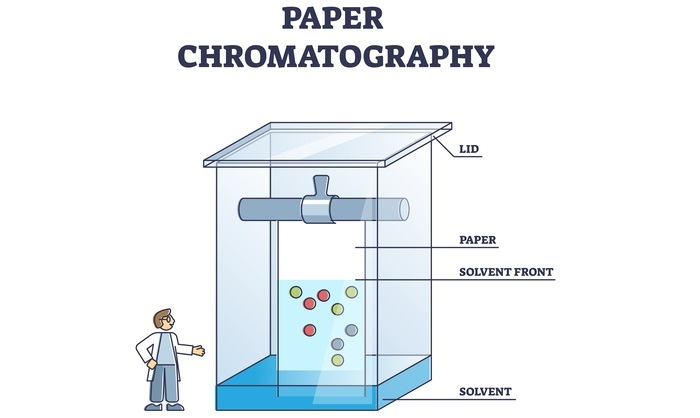
 Data Structure
Data Structure Networking
Networking RDBMS
RDBMS Operating System
Operating System Java
Java MS Excel
MS Excel iOS
iOS HTML
HTML CSS
CSS Android
Android Python
Python C Programming
C Programming C++
C++ C#
C# MongoDB
MongoDB MySQL
MySQL Javascript
Javascript PHP
PHP
- Selected Reading
- UPSC IAS Exams Notes
- Developer's Best Practices
- Questions and Answers
- Effective Resume Writing
- HR Interview Questions
- Computer Glossary
- Who is Who
Chromatographic Techniques: Types & Applications
Introduction
Chromatography is a separation technique that is used to separate and identify individual components of a mixture. The technique relies on the differential affinities of the components of the mixture for a stationary phase and a mobile phase

The stationary phase is a material that is fixed in place and the mobile phase is a fluid that moves through the stationary phase. The components of the mixture interact differently with the stationary phase and the mobile phase, which results in their separation.
Chromatography has a wide range of applications in various fields, including chemistry, biochemistry, pharmaceuticals, food science, and forensic science. The technique has evolved over the years to include various types of chromatography techniques, each with its unique set of benefits and limitations.
Explained below are the different types of chromatographic techniques and their applications in various fields.
Gas Chromatography
Gas chromatography (GC) is a type of chromatography that is used to separate and analyse volatile compounds. In this technique, the sample is vaporized and then injected into the chromatograph. The sample then passes through a column that is packed with a stationary phase, which separates the components of the sample based on their affinity for the stationary phase.
GC is widely used in the analysis of organic compounds, including hydrocarbons, fatty acids, and amino acids

Liquid Chromatography
Liquid chromatography (LC) is a type of chromatography that is used to separate and analyse non-volatile compounds. In this technique, the sample is dissolved in a liquid solvent and then injected into the chromatograph. The sample then passes through a column that is packed with a stationary phase, which separates the components of the sample based on their affinity for the stationary phase.
LC is widely used in the analysis of a wide range of compounds, including pharmaceuticals, natural products, and food additives.
High-Performance Liquid Chromatography
High-performance liquid chromatography (HPLC) is a type of liquid chromatography that is used to separate and analyze compounds at high pressure. In HPLC, the sample is dissolved in a liquid solvent and then injected into the chromatograph.
The sample then passes through a column that is packed with a stationary phase, which separates the components of the sample based on their affinity for the stationary phase. HPLC is widely used in the analysis of a wide range of compounds, including pharmaceuticals, natural products, and food additives
Ion-Exchange Chromatography
Ion-exchange chromatography is a type of chromatography that is used to separate charged particles based on their ionic properties. In this technique, the sample is passed through a column that is packed with a stationary phase that contains charged groups.
Ion-exchange chromatography is widely used in the purification of proteins, nucleic acids, and other biomolecules. It is also used in the analysis of inorganic compounds and the separation of organic acids.
Size-Exclusion Chromatography
Size-exclusion chromatography is a type of chromatography that is used to separate molecules based on their size. In this technique, the sample is passed through a column that is packed with a stationary phase that contains porous beads.
The size of the molecules determines whether they can enter the pores of the beads or not. The larger molecules cannot enter the pores and therefore elute from the column earlier than the smaller molecules.
Paper Chromatography
Paper chromatography is a type of chromatography that is similar to TLC, but uses a piece of filter paper as the stationary phase. In this technique, the sample is spotted onto the filter paper and then placed in a chamber that contains a mobile phase.
Paper chromatography is a simple and inexpensive technique that is widely used in the analysis of organic compounds, including amino acids, sugars, and lipids.

Thin-Layer Chromatography
Thin-layer chromatography (TLC) is a type of chromatography that is used to separate and identify compounds based on their differential migration on a thin layer of a stationary phase. In this technique, the sample is spotted onto a thin layer of stationary phase that is coated on a plate.
The plate is then placed in a chamber that contains a mobile phase, which moves up the plate via capillary action. The components of the sample will move at different rates on the plate based on their affinity for the stationary phase and the mobile phase.
TLC is widely used in the analysis of organic compounds, including drugs, pesticides, and natural products. It is also used in forensic science and in the identification of unknown compounds.
Applications of Chromatography Techniques
Chromatography techniques have a wide range of applications in various fields, including ?
Pharmaceutical Industry: Chromatography techniques are widely used in the pharmaceutical industry for the analysis and purification of drugs. HPLC is the most commonly used technique for the analysis of drugs, while affinity chromatography is used for the purification of proteins and other biomolecules.
Food Industry: Chromatography techniques are used in the food industry for the analysis and purification of food additives, flavours, and fragrances.
Environmental Science: Chromatography techniques are used in environmental science for the analysis of pollutants and contaminants in air, water, and soil. GC is commonly used for the analysis of volatile organic compounds.
Forensic Science: Chromatography techniques are used in forensic science for the analysis of trace amounts of drugs, explosives, and other volatile compounds.
Biotechnology: Affinity chromatography is commonly used for the purification of proteins and other biomolecules, while size-exclusion chromatography is used for the analysis of protein aggregates and the determination of molecular weight.
Petrochemical Industry: GC is commonly used for the analysis of volatile organic compounds in petroleum products, while HPLC is used for the analysis of non-volatile organic compounds.
Clinical Diagnostics: Chromatography techniques are used in clinical diagnostics for the analysis of biomolecules in blood and other bodily fluids.
Cosmetics Industry: Chromatography techniques are used in the cosmetics industry for the analysis and purification of fragrances, flavours, and other additives.
Conclusion
Chromatography techniques are powerful tools for the separation, purification, and analysis of complex mixtures of molecules. These techniques have a wide range of applications in various fields, including pharmaceuticals, food, environmental science, forensic science, biotechnology, petrochemicals, clinical diagnostics, and cosmetics.
The choice of chromatography technique depends on the specific requirements of the analysis or purification, such as the size and polarity of the molecules, the sensitivity of the detection, and the amount of sample available. Each technique has its own strengths and limitations, and a combination of techniques may be required to achieve the desired separation and purification.

